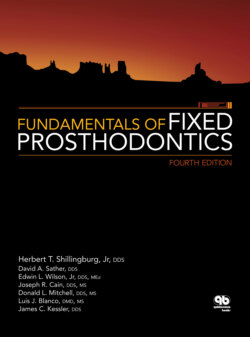Читать книгу Fundamentals of Fixed Prosthodontics - James C. Kessler - Страница 32
На сайте Литреса книга снята с продажи.
Determinants of mandibular movement
ОглавлениеThe two condyles and the contacting teeth are analogous to the three legs of an inverted tripod suspended from the cranium. The determinants of the movements of that tripod are, posteriorly, the right and left TMJs; anteriorly, the teeth of the maxillary and mandibular arches; and overall, the neuromuscular system.20
The dentist has no control over the posterior determinants, the TMJs; they are unchangeable. However, they influence the movements of the mandible, and of the teeth, by the paths that the condyles must travel when the mandible is moved by the muscles of mastication. The measurement and reproduction of those condylar movements is the basis for the use of articulators.
The anterior determinant, the teeth, provides guidance to the mandible in several ways. The posterior teeth provide the vertical stops for mandibular closure. They also guide the mandible into the position of maximal intercuspation, which may or may not correspond with the optimum position of the condyles in the glenoid fossae. The anterior teeth (canine to canine) help to guide the mandible in right and left lateral excursive movements and in protrusive movements. Anterior teeth are especially suited for guidance by virtue of:
Canines having the longest, strongest roots in their respective arches
The load being reduced by distance from the fulcrum (Class III lever)
The proprioceptive threshold and concomitant reflexes reducing the load21–23
Dentists have direct control over the tooth determinant by orthodontic movement of teeth; restoration of the anterior lingual or posterior occlusal surfaces; and equilibration, or selective grinding, of any teeth that are not in a harmonious relationship. Intercuspal position and anterior guidance can be altered, for better or for worse, by any of these means.
The closer a tooth is located to a determinant, the more it will be influenced by that determinant (Fig 2-10). A tooth located near the anterior region will be influenced greatly by anterior guidance and less by the TMJ. A tooth in the posterior region will be influenced partially by the joints and partially by anterior guidance.
The neuromuscular system, through proprioceptive nerve endings in the periodontium, muscles, and joints, monitors the position of the mandible and its paths of movement. Through reflex action, it will program the most physiologic paths of movement possible under the set of circumstances present. Dentists have indirect control over this determinant through procedures performed on the teeth, which may affect the response of the neuromuscular system.
One of the objectives of restorative dentistry is to place the teeth in harmony with the TMJs. This results in minimum stress on the teeth and joints, with only a minimum effort expended by the neuromuscular system to produce mandibular movements. When the teeth are not in harmony with the joints and the movements of the mandible, an interference is said to exist.
Fig 2-10 The farther anterior a tooth is located, the less the influence of the TMJ and the greater the influence of the anterior guidance (AG).
